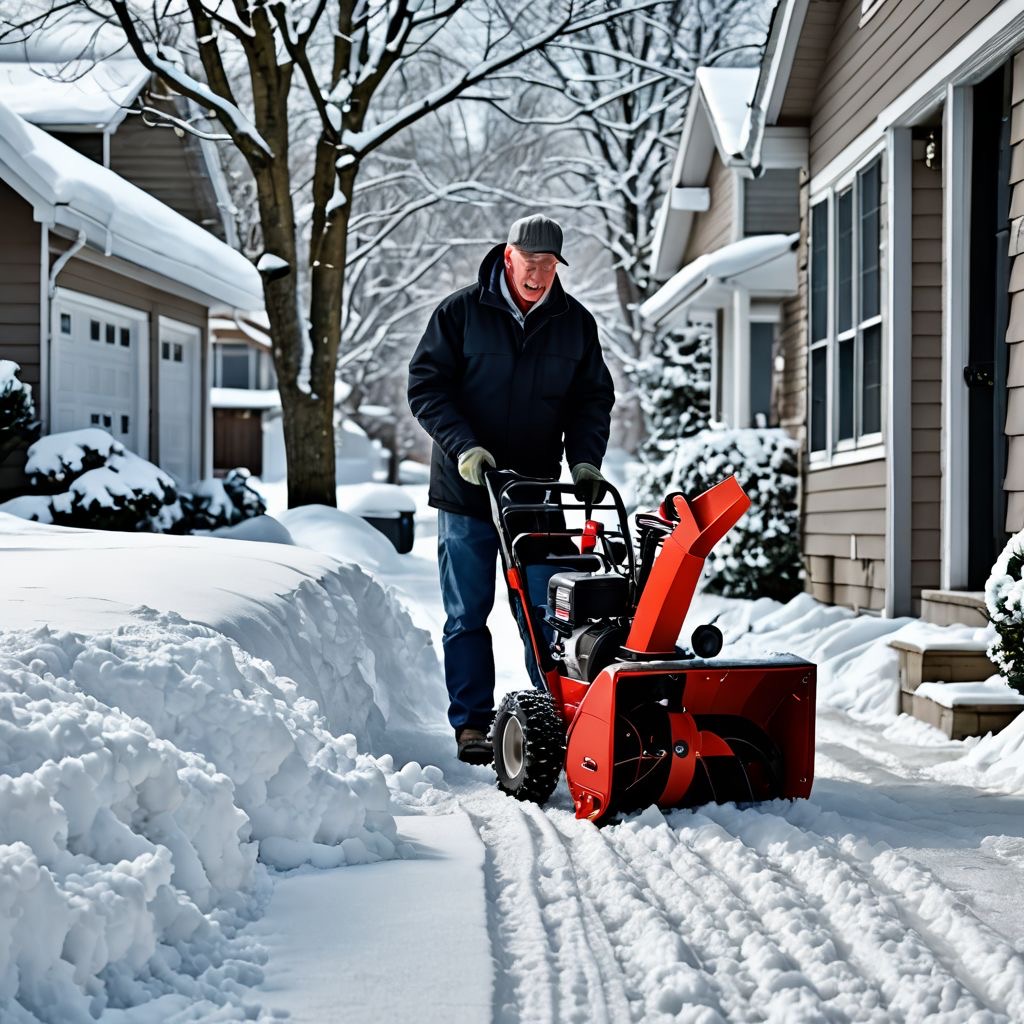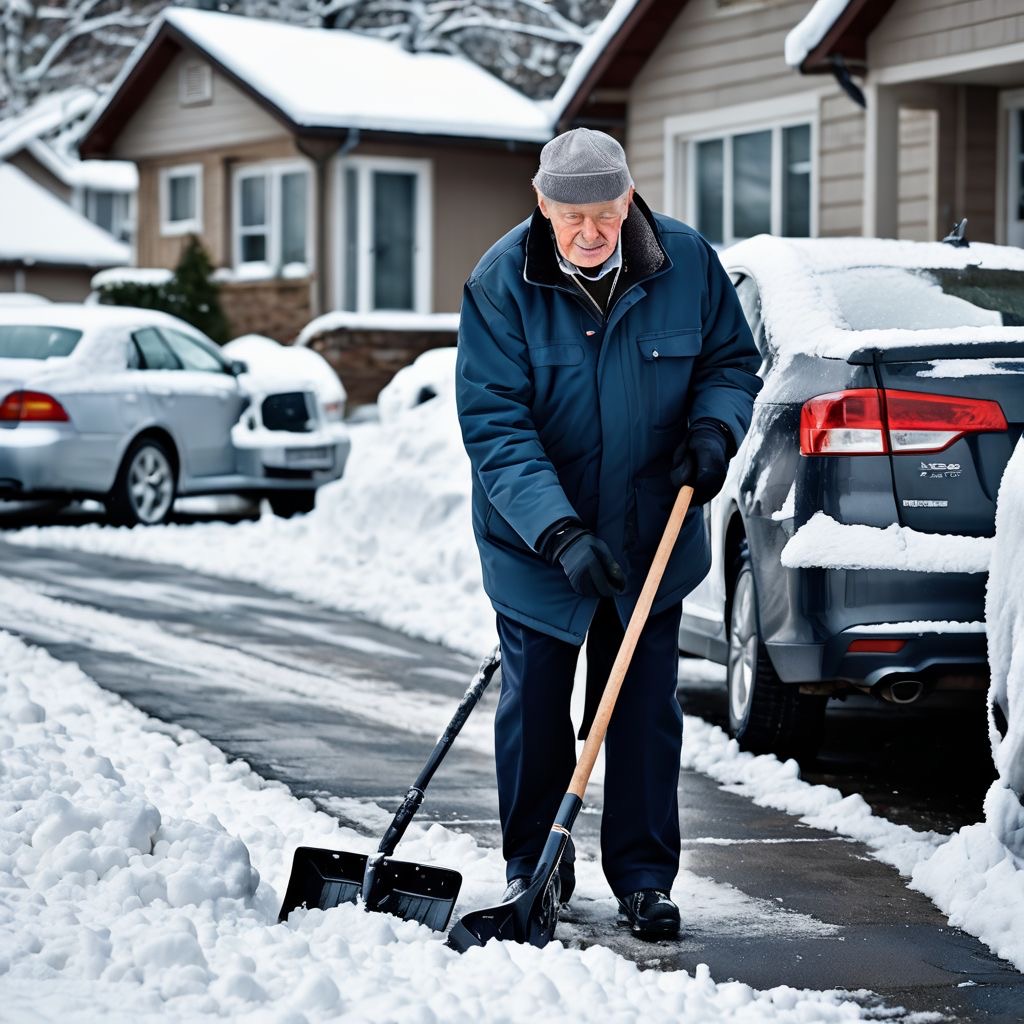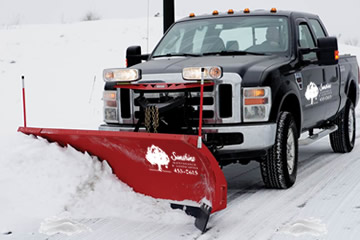
Introduction:
As winter blankets Winnipeg with snow, our picturesque landscape can quickly turn into a daunting challenge for homeowners. Snow shoveling, often viewed as a necessary chore, poses significant health risks, particularly for certain populations. Between 1990 and 2006, an average of approximately 11,500 people were treated annually for snow-shoveling-related incidents, including 1,647 cardiac-related deaths during that period, according to a peer-reviewed study published in 2010. This alarming data underscores the need for awareness and caution when engaging in this seemingly innocuous winter activity. This essay will explore the health dangers associated with snow shoveling, the physiological impacts on the body, the demographic most at risk, and strategies to mitigate these risks.
Contact us today for your free estimate.
A need for caution!

Shoveling snow and heart attack:
According to past estimates, about 100 people — mostly men — die during or just after shoveling snow each year in Canada and the US. Many more are admitted to hospital emergency wards with severe chest pain and/or other heart problems. Latest research further explored the details of this connection. Researchers correlated admissions to hospitals and found that the day after it snowed in Canada during the years 1981 to 2014 there were more than 128,000 hospital admissions and more than 68,000 deaths due to heart attack. Here's what they found:
Its truly shocking how many people (men) die each year from snow shovelling

-
The deeper the snow, the more men were admitted for heart attacks. For example, for snowfalls of more than eight inches, there was a 16% increase in hospital admissions compared to days with no snow.
-
The deeper the snow, the more men died of heart attacks. A 34% increase was observed the day after an eight-inch snowfall, and higher rates were noted when even more snow fell.
-
Similar observations were made for the duration of snowfall. The longer it snowed, the higher the rates of heart attack and related deaths among men.
-
Interestingly, a link between snowfall and heart attack was not observed among women.
The findings of this study were not limited to people who already knew they had heart disease or who had risk factors for it. The link between snowfall and heart attack was observed even among people with no cardiovascular risk factors such as smoking or high blood pressure.
Contact us today for your free estimate.
It's worth mentioning that this study did not ask the patients whether they actually shoveled snow. So, it's possible that the connection between snowfall and heart trouble is not directly related to actually shoveling snow. There may be some other snow removal related risk factor at play here, perhaps it's the use of a snow blower that is the real culprit.

Why should this be?
The link between snowfall and heart attack is apparent for several reasons:
-
Shoveling snow (or perhaps other means of snow removal, including pushing a heavy snow blower) will often raise your heart rate and blood pressure much more quickly and more dramatically than many other types of exercise.
-
Snow shoveling requires use of arm muscles, which for most people is more strenuous than other exercise.
-
Snow removal happens in a cold environment. That's important because cold temperatures may cause blood vessels to constrict.
-
Many snow shovelers are ordinarily sedentary. The sudden, strenuous workout can tax a body that is not prepared for it.

And, as mentioned, there is no obvious or highly likely alternative explanation. A number of previous research has also linked snow shoveling with an increase in the risk of a cardiac event.
This study cannot prove a causal link between snow shoveling and heart attack and,, it cannot rule out a snow shovelling/heart attack link for women as well. It makes one wonder if the lack of a connection for women observed in this study may have just been because fewer women were the ones shovelling snow and looking after snow removal following a snow fall.
Discover how Sunshine Maintenance & Landscaping can help you with your Winnipeg yard
So what?
Knowing that each year, heart disease affects more than 30 million people in Canada and the US and takes hundreds if not thousands of lives each year, eliminating snow shoveling-related heart attacks and deaths would have a meaningful impact. Especially if that person who died was your husband, father or other family member. While shoveling snow can certainly trigger heart trouble, this study also strongly suggests that not shoveling may represent a preventive strategy worth considering. Many people invest a great deal of effort into diet, exercise and lifestyle choices in an effort to live longer and healthier lives. Making the choice not to shovel snow again may be one of the wisest choices available.
Not shovelling may be a very good lifestyle choice?

So, if you have snow where you live, like we do here in Winnipeg, and you're on the fence about whether to hire the neighborhood kid or a professional snow removal service to shovel your driveway and walk, this body of research may persuade you to just go ahead and give someone else the job.
Contact us today for your free estimate.
The Physiological Impact of Snow Shovelling:
Snow shoveling can be a physically demanding task that can place considerable stress on the body. The act of shoveling snow involves repetitive lifting, twisting, and pushing motions that require significant physical exertion. For many, especially those who are not regularly active, the sudden increase in physical activity can lead to various health issues.
1. Cardiovascular Strain: The heart rate can increase significantly while shoveling, often reaching levels comparable to those experienced during vigorous exercise. This increase in heart rate, coupled with the cold temperatures, can cause blood vessels to constrict, raising blood pressure. For individuals with pre-existing heart conditions or risk factors, this combination can be particularly dangerous, potentially leading to heart attacks or arrhythmias.
2. Musculoskeletal Injuries: Snow shoveling can also result in musculoskeletal injuries. The repetitive motions involved can lead to strains and sprains, particularly in the back, shoulders, and arms. Improper lifting techniques can exacerbate these injuries, leading to chronic pain or long-term disability.
3. Hypothermia and Frostbite: Exposure to cold temperatures while shoveling can lead to hypothermia or frostbite, especially if individuals are not dressed appropriately. These conditions can be life-threatening and require immediate medical attention.
Demographic Vulnerability:
Certain populations are more vulnerable to the health risks associated with snow shoveling. According to Barry Franklin, director of Preventive Cardiology and Cardiac Rehabilitation at Beaumont Health in Royal Oak, Michigan, individuals over the age of 45, particularly those with heart disease or who suspect they have heart disease, should consider avoiding shoveling altogether.
1. Age: As people age, their cardiovascular systems may become less resilient. Older adults are more likely to have pre-existing health conditions, making them more susceptible to the dangers of strenuous physical activities like snow shoveling.
2. Pre-existing Health Conditions: Individuals with heart disease, high blood pressure, or other cardiovascular risk factors face a heightened risk when shoveling snow. The American Heart Association emphasizes the importance of managing these conditions through lifestyle changes and medical interventions.
3. Sedentary Lifestyle: Those who lead a sedentary lifestyle are at greater risk when faced with sudden physical exertion. The lack of conditioning can result in a higher likelihood of injury or adverse health events during activities like shovelling.
Contact us today for your free estimate.
The Statistics, A Call for Awareness:
The statistics surrounding snow shoveling-related incidents are sobering. The average of 11,500 annual treatments for snow-shoveling-related injuries highlights the frequency of these events. The very substantial number of cardiac-related deaths over the years is a stark reminder of the potential fatal consequences of this winter task. These numbers serve as a call to action for individuals, healthcare providers, and communities to raise awareness about the risks associated with snow shoveling. Public health campaigns can play a crucial role in educating the public about safe practices and the importance of recognizing personal limitations.
Winnipeg Rooftop Snow Removal: How to Do It, Safety Considerations and More
Not all snow shovelling-related injuries result in death but their frquency is definately sobering.

Mitigating the Risks:
While snow shoveling is often unavoidable in many regions, there are several strategies individuals can adopt to reduce the associated health risks.
1. Know Your Limits: Individuals should be aware of their physical condition and limitations. Those with heart conditions or other risk factors should consult with their healthcare provider before engaging in snow shovelling.
2. Use Proper Techniques: Learning and employing proper shoveling techniques can help minimize the risk of injury. This includes bending at the knees, keeping the back straight, and using the legs to lift rather than the back.
3. Take Breaks: It is essential to take frequent breaks while shoveling to rest and hydrate. This can help prevent overexertion and reduce the risk of cardiovascular strain.
4. Dress Appropriately: Wearing layers of clothing can help regulate body temperature and reduce the risk of hypothermia. Waterproof gloves and boots are also essential to protect against frostbite.
5. Consider Alternatives: Considering alternatives to shovelling is a very wise choice. Hiring a snow removal service, or enlisting the help of family or friends can alleviate the burden and reduce health risks.
Ready to chat about your snow management needs?

Reach out by call or text to: 204-229-9789 or click here to submit your information today to arrange a “no obligation” introductory phone call. We look forward to helping you with your yard.
Tips on how to prepare for a consultation meeting with a contractor
6. Stay Informed: Being aware of the signs of a heart attack is critical. Symptoms such as chest pain, shortness of breath, or discomfort in the arms, neck, or jaw should prompt immediate cessation of activity and a call for help.
7. Just say No: Perhaps one of the clearest and safest choices is to just say no to snow shovelling altogether. Even though us guys believe that something bad will never happen to us, It's clearly just not worth the risk. Just say no, as a favour to those around you who care more for your health and you being in their life than they do for you clearing the snow in your driveway or sidewalk.
Contact us today for your free estimate.
Reaching out to a contractor to handle your snow shovelling, snow plowing and snow removal needs:
The No-Risk to your health option

As winter approaches, for many homeowners, snow accumulation can present many challenges, as we have read,particularly when it comes to health & safety. Hiring a reliable contractor can alleviate these concerns. When searching for “Winnipeg snow shovelling near me" or “snow removal service near me, ” it makes sense to choses a contractor with local expertise. Local companies will be familiar with the specific challenges posed by winter weather in Winnipeg, including the frequency and intensity of snow falls.
Our Experience - choose carefully:

At Sunshine Maintenance & Landscaping, we've been in the business of Winnipeg snow shovelling, snow plowing and snow removal for over 30 years. Looking after residential and commercial customers when they have needed us the most. We're proud of that. Over the years, we have seen a number of times where someone with a truck and a shovel decides to get into the snow removal business, not really understanding what they're in for. In one recent example, we had two severe snow storms within a couple of weeks. Unfortunately, that was more than this particular individual was prepared for, equipped with two regular shovels and only one fairly inexpensive electric snow shovel, he was completely overwhelmed. So, he “bailed”, packed it in, quit and left his customers, with no prior notice with driveways and sidewalks piled high with drifted snow, trying to find a new service provider when they were all as busy as could be and not really able to take on any new client. The type of equipment a contractor uses can significantly impact the efficiency and effectiveness of clearing snow from a property. It's wise to inquire about the equipment a contractor has available. Contractors who invest in modern, commercial grade equipment are much more likely to provide you with reliable and efficient service.
Conclusion:
Snow shoveling is a common winter activity that definitely poses real and significant health risks, particularly for certain demographics. The statistics surrounding snow-shoveling-related incidents, including deaths serve as a stark reminder of the potential dangers associated with this seemingly innocuous task. Understanding the physiological impacts, recognizing demographic vulnerabilities, and adopting strategies to mitigate risks are essential for ensuring safety during our winter months. By fostering awareness and promoting safe practices, individuals can enjoy the beauty of winter while minimizing the health risks associated with snow shoveling. Ultimately, prioritizing safety and health should be at the forefront of winter activities, allowing everyone to appreciate the season without compromising their well-being. Remember, please stay safe!

